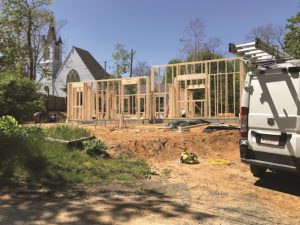WELLFLEET — Wellfleet’s stock of historic houses was reduced by one when the new owner of 15 Squires Pond Lane in the town center dismantled the 170-year-old section of the structure that he was supposed to preserve.
Ricardo Rovero, who owns Engineered Construction International of Plainfield, Conn., said the building was crumbling and could not be saved. “From the outside, it looked intact, but there weren’t enough good bones,” he said by phone last week.
Time and powder post beetles had done the old building in, he said.

Rovero, who lives in North Grosvenordale, Conn. and owns property in Truro, bought the deteriorated house for $340,000 in March 2021. He initially planned to demolish the building and construct something similar. The Wellfleet Historical Commission, after checking with Sarah Korjeff, the historic preservation specialist for the Cape Cod Commission, gave Rovero permission to demolish later additions but said the oldest section, a small saltbox, must be preserved.
“Demolishing and rebuilding the structure in the same form would mean losing all the original structural frame and materials that can reveal this building’s history,” said Korjeff in a memo to the historical commission. “Siding and roofing materials are expected to be replaced over time, but the original structural frame and sheathing materials used in the early 1800s were made to last for centuries.”
Korjeff advised the commission to “work with the applicant to retain the oldest and most unique portions of the structure and marry them with areas of new construction.”
Rovero planned to rebuild within the existing footprint and set new additions back to differentiate them from the historic structure. The commission directed him to use the single-pane original door or a reproduction on the historic section.
Rovero secured his building permit in late December. He said he had assumed that, underneath all the layers of plaster, the old section would be post and beam. Instead, he said, he found those supports had been shored up and sections had been replaced over the years. Jacking this part of the house up to put in a foundation proved impossible, he said. And, he added, “When we started to take off the roof, it crumbled.”
Rovero then dismantled the saltbox and laid the sections against a shed on the site.
When Building Commissioner James Badera saw that the work was not what had been authorized on Rovero’s building permit, he issued a stop-work order on April 7. Rovero immediately contacted him, saying the original saltbox was structurally unstable and unsafe.
Badera directed him to submit his revised building plans and schedule a meeting with the historical commission to explain what had happened. Once Rovero complied, Badera lifted the stop-work order.
During the historical commission’s meeting with Rovero earlier this month, chair Gordon Kahn expressed dismay at the turn the project had taken.
“I’m so disappointed that things have shaken out this way,” Kahn said, adding that Rovero should have halted work as soon as he discovered the wood had rotted instead of going ahead with demolition.
When Kahn asked whether any part of the original building could be used, Rovero said all the supports were far too decayed. “What we have on-site could be used potentially somewhere else,” said Rovero, who offered to deliver it to anyone interested.
Kahn asked if there was an old beam in the pile that could be used decoratively, and commissioner Timothy Curley Egan brought up the windows. “Some are in pretty good shape,” he said. “They could be used in strategic spots.” Rovero was doubtful they would meet current energy standards but said a couple could be used in an outbuilding.
Left with little choice, the commission noted that the historic portion of the house could not be saved and accepted the new plan with the stipulation that Rovera use as much of the original as he can decoratively in the house or one of the outbuildings.
Kahn stressed that the commission’s decision did not set a precedent.
Kahn followed the acceptance motion with a final admonition to Rovero: “If something goes wrong, you’ve got to tell Jim [Badera] and you’ve got to tell us.”
In a phone interview, Kahn said Rovero made every effort to produce a compatible design for the new house, but because of building code changes the scale is larger even if it’s kept to the original footprint.
“As you drive around the village, there is a consistency of scale that’s unique to Wellfleet,” Kahn said, describing part of what he had hoped would be preserved.
Rovero said the new house, which should be finished by October, would blend right in. “It may not have the same wood, but it will have the same character,” he said.
He said he purchased the Wellfleet property with the idea of selling the new house to a colleague for whatever the project ultimately costs him.



